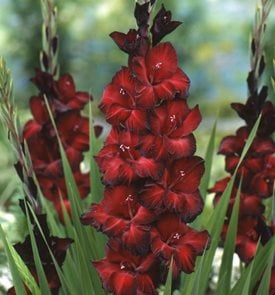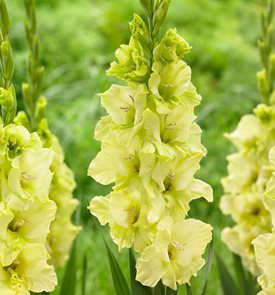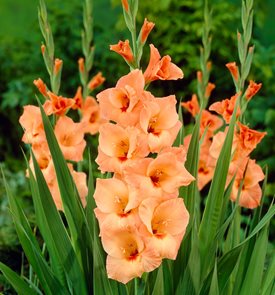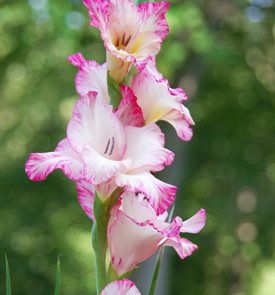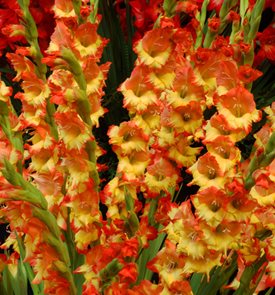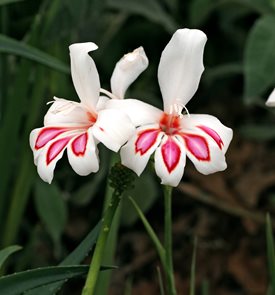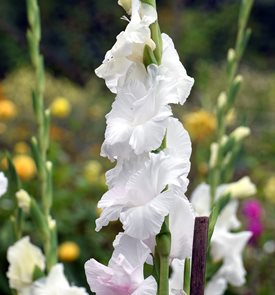Gladiolus - How to Grow Gorgeous Gladiolus Flowers
Plant gladiolus in spring for spectacular cut flowers all summer long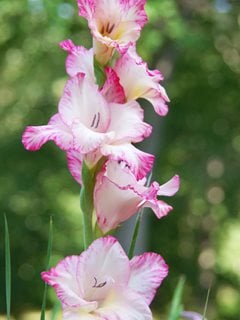
Photo by: Shannon Marie Ferguson / Shutterstock.
Gladiolus flowers are a gold standard in the florist trade, but they are also easy and economical to grow at home. Avid glad fans often fill entire rows or garden beds with them for use in bouquets, and others choose to keep them with other perennial flowers in the garden—where hummingbirds really love them!
On this page: Basics | Types | Planting | Care | Pictures | Cut & Display Glads
On this page:
- BASICS
- TYPES
- PLANTING GLADIOLUS
- GLADIOLUS CARE
- GERBERA DAISY PICTURES
- HOW TO CUT & DISPLAY GLADIOLUS
BASICS
Botanical name:
Gladiolus xhortulanus
Common names:
Common gladiolus, garden glad, and sword lily (because of the long, pointed leaves)
Zones:
Perennial in zones 8-10. Can be grown as annuals in zones 2-7. Some G. nanus types are hardy to zone 4 or 5.
Plant type:
Although often labeled as “summer bulbs,” gladioli are herbaceous perennials that grow from bulb-like corms covered with a fibrous papery skin.
Exposure:
Full sun
Height:
1 to 5 feet
Bloom time:
From early summer until frost, depending on the cultivar and when the corms are planted.
Flower characteristics:
Glads come in nearly any color and shade (except for true blue) in both solid and multicolored forms. Depending on the cultivar, the petals may be frilly, ruffled, semi-ruffled or plain, and the size can range from miniature (under 2 ½ inches in diameter) to gigantic (over 5 inches). The flowers are typically arranged on only one side of the stem and open in succession from the bottom up, with the largest flower at the base.
TYPES OF GLADIOLUS
You’ll find countless cultivars of glads in local garden centers and catalogs, all derived from various combinations of more than 250 species, most of which are native to southern and central Africa and Eurasia.
The three main glad groups are:
- Grandiflora: The largest group of garden cultivars. These hybrids are the showiest of the bunch, with blooms up to 6 inches wide and the most extensive range of colors.
- Nanus: Another group commonly grown in the garden. Miniature hybrids that tend to be more cold-tolerant than their taller cousins.
- Primulinus: Have daintier hooded flowers and very narrow leaves.
PLANTING GLADIOLUS
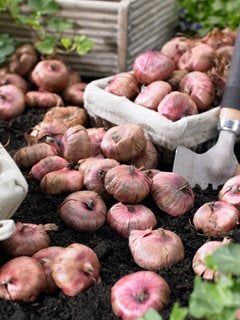
Gladiolus corms ready for planting. Photo by: Longfield Gardens.
When to plant:
Start planting glad corms as early as a month before the average last frost date in your area. Depending on the cultivar, gladiolus take an average of 90 days after planting before they flower. Stretch the blooming season by succession planting corms at two-week intervals through early July and by mixing varieties that mature at different times. Make your last planting about 12 weeks before the first frost date.
Where to plant:
Plant glads in flower beds and borders, vegetable gardens, cut flower gardens, and even containers. All they need is a sunny location that is protected from wind to avoid damage to the tall flower stalks. Use them to fill spaces and add vertical interest in an established flower garden, as they will bloom in late summer when many other flowers fade.
Planting depth and spacing:
Gladiolus corms can vary in size, depending on the type. For best results, follow the recommendations given on the package. Always plant corms with the flatter side facing downward, and the pointed end facing up.
Soil:
Glads aren’t fussy and will thrive in many different soil types, but well-drained soil is a must. Before planting, work the soil several inches deeper than the planting depth of the corm and amend it with organic matter if necessary.
For more on planting and storing bulbs:
GLADIOLUS CARE
Staking:
Glads that grow 3 to 4 feet or taller will probably need to be staked or caged to prevent the stalks from bending and breaking. Set the stakes in the ground at planting time to avoid damage to the corms.
Watering:
After planting, water glads thoroughly and then keep the soil evenly moist throughout the growing season. During dry weather, soak the ground thoroughly to supply the equivalent of an inch of rainfall per week. To help conserve moisture and control weeds, apply a 2- to 4-inch layer of mulch around your plants. (See How to Mulch and Avoid Mistakes.)
Pest problems:
The biggest threat to gladioli are thrips, tiny flying insects that feed on the foliage and flower buds. Thrips are hard to spot without a magnifying glass, so watch your glads for signs of thrip damage, which includes silvery streaks and small white patches on the leaves and buds that fail to open.
Winter care & storage:
After a glad blooms, the original corm begins to wither away and a new one forms for the next year’s growth. In areas where gladiolus aren’t hardy, you can overwinter the newly formed corms until the following spring by digging them up in fall once the foliage has been killed by frost. Here are the basic steps:
- Cut the flower stalks off just above each corm, brush or wash off the soil, and then allow the corms to dry in a well-ventilated area for a couple weeks.
- Separate the new corms from the old ones, layer them in a cardboard box with newspaper in between, and store them in a dark, dry, cool area (ideally 35 and 45 degrees F).
- Some corms also produce cormels—smaller plantlets that can be separated from the parent and grown into new plants. However, cormels often won’t produce blooms for several years and are best discarded.
- If you have a variety of glads, label the corms by color or cultivar before storing.
- Check your corms periodically to make sure they are in good condition. If they have started to sprout new growth, move them to a cooler spot. If you notice signs of rot, the packing material may be too moist.
- If you don't want to fuss with digging up and storing the corms each year, simply treat them as annuals and buy new ones every spring.
GLADIOLUS PICTURES
HOW TO CUT & DISPLAY GLADIOLUS FLOWERS
- Generally, glads will remain attractive for at least a week in a vase; but for the greatest longevity, cut the stems when only a few flowers are open at the bottom of the flower spike. The rest of the florets will open gradually over the next few days. Pull off the bottom florets when they fade.
- Cut the flower stalks in the early morning or late evening—when temperatures are coolest and the stems are well hydrated. If you plan to store and replant your corms, leave as many leaves as possible on the plant to help nourish the corm for the following spring.
- Although glads look stunning arranged in a tall vase, you can also cut the blooms from the stems and arrange them in a shallow vase or bowl for an attractive, low-profile centerpiece.
HOW & WHERE TO BUY GLADIOLUS CORMS
- You can purchase glad corms individually, but it’s often more convenient to buy a color-coordinated mix that will look harmonious in a vase or the garden with little effort. Many bulb suppliers offer an array of popular color schemes, such as pastels, bright summer blends, rainbow mixes, and more.
- Look for corms that are at least an inch in diameter and ones that are relatively tall and plump rather than wide and flat. Larger corms will produce larger, more robust blooms.
RELATED:
Summer Bulbs
How to Grow and Care for Crocosmia
Cottage Garden Design Ideas
